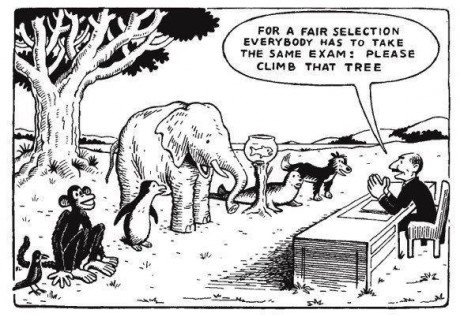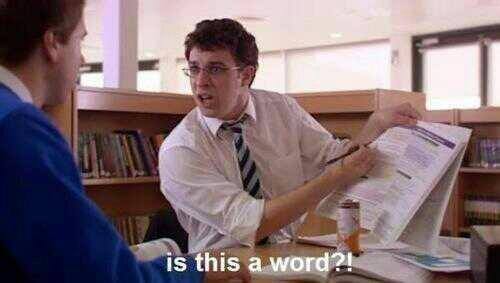Since the beginning of this module, I have been spending some time watching presentation videos from TED (Technology, Education and Design), particularly focusing on the education videos. This got me thinking, is there something wrong with our education system? We are taught from a very early age that ‘practice makes perfect’ and that it is through this method that we can improve our skills. However, in my particular case, I had spent a massive amount of time studying English and doing test every other week, during college. This was all in preparation for my coming to the UK to study, as universities here require a certain level of English to accept international students. So I took my IELTS exam after all the hard work and achieved 6.5 overall in my scores, but ironically I don’t find my English strong enough to communicate with local students and to express myself. I felt that the education system did not work around my needs rather more around a set standard way. Therefore shouldn’t educations systems stop using standardized teaching and promote more creativity in order to help students actually learn and not get high grades?
Importance of Creativity
Creativity is very important for people to develop and is evident in different aspects of life. Building upon the quality of creative thinking, individuals are allowed to benefit from innovative technology, aiding the whole education system to achieve a better understanding of specific needs from learners and establish a more solid foundation for a creative world. In 2010, Naderi et al did a study on creativity and used 153 undergraduate students from Malaysian Universities and found that significantly, creativity is positively related to academic achievement for both genders (Male: p < .003; Female: p < .001).
For individuals with healthy mental status, creative strategies of learning new language helps them to understand a new language (Argondizzo, 2012). Despite being important on learning new information, implementing innovations in technology to advance therapies such as behavioral parent training (BPT), can help children with disruptive behaviors to promote mental health (Jones, 2013).
In addition to the implication of creativity, many research indicate that creativity is now one of the critical assessment of individuals’ job performance because of the growing competition between companies to continuously improve and adapt new ideas (Gong et al, 2012; Ford & Gioia, 2000).
Potential Biases: Standardisation, Test-based Acceptance, Conformity
Unfortunately according to Ravitch (2003), educators are being influenced by political circumstances, in which facilitates the use of standardized education system been brought into the classroom. Meaning teachers do not have the ability to majorly change how a module may be taught even if it may help the learners understand better. Instead it is just the typical sit down, listen to the teacher talk and write about it in homework afterschool.
From the learners’ perspective of standardisation, it would prevent them to share their creative ideas, in order to avoid unfavorable evaluation or being viewed as divergent (Gough, 1979). For example, a preschooler has a talented skill on drawing that he is capable at more complex art such as drawing the human hand with detailed fingers; however, a teacher may see this as distant from what preschoolers are meant to learn, and may instruct him instead to draw a circle shape as human hand. With the happening of these events, the child would have built up an unconscious status of the “threat of negative evaluation” and gradually become reluctant to show their creativity (Bowers, 1967).
Sahlberg and Boce (2012) argued that spending a majority of time to do massive amounts of coursework or examinations, and many hours listening and receiving message from a teacher is not helpful in nurturing students’ creativity. This caused concern and Robinson (2006) believed that creativity is hindered by the environments which enforce conformity.
Another researcher, Abbate (2010), suggested that there are concerns about how leadership in education can affect learning. Leaders may take conformity as accounted for the quality of work or idea. This issue can be directly associated with the education system. Is the education system conformed to the integrity of parents and expectations of society by giving standardized exams to students, rather than giving real care to their potential talents? If a student got high grades but forgot everything straight after the exam, would please future employers and possibly parents but what about those that do not do so well in exams but may understand better and in the end actually learn more than high achivers?
An example of this conformity issue would be the Desirable Outcomes for Children’s Learning (DLOs). DLOs was the first education system that is applied to a large range of pre-school provision, and was supervised by OfSTED. When meeting the supervisor’s regulations becomes an education leader’s priority, the only processes that are accepted are those that show conformity, but not those that support creativity. At last, there was an agreement of being “open to misinterpretation” for the settings of DLOs (QCA, 2000).
Any Real-life Examples that the Potential Biases Cause Concerns in the Society?
The most frequently seen example is nurses being taught to conform and comply with higher authorities, such as doctor. In a famous experiment by Hofling et al (1966), they did it by asking twenty-two nurses to put on medication for a patient through the phone from an unknown doctor, in which the volume of medicine required was over the maximum volume for one injection. Surprisingly, only one nurse did not comply with the instruction. Besides, according to McDonald and Ahern (2000), nurses who speaking out against poor medical practice are more likely to receive severe reprisals from colleagues, such as peer rejection and even threats.
Yet another example occurs in the management of a company, that standardisation is commonly utilized in a company structure to monitor all internal staff and allow them to have a set of regulation, minimizing mistakes. However, facing the serious competition, company has a dilemma situation that it is difficult for them to balance between innovative management and standardised system. The use of innovation brings a continual change to the company and requires for a more informal structure; that is against standardisation, which functions to reduce variance (Benner & Tushman, 2003). Nevertheless, Worren et all (1999) argued that a supportive relationship can exist between innovative and standardised management, and both systems rely on each other. So, why can’t the same thing happen to our education system?
Evolution of the Current Education System
To create a more complex application of standardisation and creativity, a minority of education leaders is putting their contribution to add the element of creative thinking in the current education system. It is important for organisations such as Centre for Creative Leadership, Creative Education Foundation (CEF) and Creativity, Culture and Education (CCE) have a good development, because it can gain confidence for the educators to utilize innovation in the future system setting.
On the other hand, researchers struggle to find the means to facilitate the formation of creativity, and examples of the research would be that Wang (2012) did a literature review on creativity thinking; whereas Agina (2012) investigating the effect of nonhuman’s external regulation on children’s creativity. She summed up many studies and suggested four main dimensions that should be implemented when educating students:
“1) cognitive: thinking, remembering, reasoning;
2) motivation: self-discovery, courage, curiosity, willingness, task commitment;
3) personality: self-confidence, self-esteem, determination, persistence, tolerance for ambiguity, openness to new experiences
4) society: abundant resources, independence, nonconformity.”
This kind of research would help the educators to identify and implement new teaching skills, which allows the current education system to evolve into a better stage.
Conclusion
It is hard to recognize the effect of standardisation, test-based acceptance and conformity on creativity thinking, because there are not many experimental research done on these fields. However some evidence does seem to indicate the importance of creativity to learning and should be implemented into the education system. In the current education system setting, the setting is aligned with some learners and allows them to contribute their creativity, but a certain number of learners cannot properly adapt their potential talents in it, and it burdens their gifts. Therefore, I hope further “creative” investigations will be done to help them (I’m one of them btw…) out. Anyway I hope you guys would enjoy my first blog.
References
- Abbate, F. J., (2010). Education Leadership in a Culture of Compliance. Phi Delta Kappan, 91(6), 35-37.
- Agina, A. M., (2012). The effect of nonhuman’s external regulation on young children’s creative thinking and thinking aloud verbalization during learning mathematical tasks. Computers in Human Behavior. 28(4), 1213-1226.
- Argondizzo, C. (2012). Creativity and Innovation in Language Education (Ed.). Bern: Peter Lang.
- Benner, M. J., & Tushman, M. L., (2003). Exploitation, exploration, and process management: the productivity dilemma revisited. Academy of Management Review, 28(2), 238-256.
- Bowers, P. G. (1967). Effect of hypnosis and suggestions on reduced defensiveness on creativity test performance. Journal of Personality, 35, 311-322.
- Ford, C. M., & Gioia, D. A., (2000). Factors influencing creativity in the domain of managerial decision making, Journal of Management, 26(4), 705-732.
- Gong, Y., Cheung, S., Wang, M., & Huang, J. (2012). Unfolding the Proactive Process for Creativity. Journal of Management, 38(5), 1611-1633.
- Gough, H. G. (1979). A creative personality scale for the adjective check list. Journal of Personality and Social Psychology, 37, 1398-1405.
- Hofling, C. K., Brotzman, E., Dalrymple, S., Graves, N., & Pierce, C. M. (1966). An Experimental Study in Nurse-physician Relationships. Journal of Nervous and Mental Disease, 143, 171-180.
- Jones, D. J., Forehand, R., Cuellar, J., Kincaid, C., Parent, J., Fenton, N., & Goodrum, N. (2013). Harnessing innovative technologies to advance children’s mental health: Behavioral parent training as an example. Clinical Psychology Review, 33(2), 241-252.
- McDonald, S., & Ahern, K. (2000). The Professional Consequences of Whistleblowing by Nurses. Journal of Professional Nursing, 16(6), 313-321.
- Naderi, H., Abdullah, R., Aizan, H. T., Sharir, J., & Kumar, V., (2010). Relationship between creativity and academic achievement: A study of gender differences. Journal of American Science, 6(1), 181-190.
- Qualifications and Curriculum Authority (QCA) (2000). Curriculum guidance for the foundation stage, QCA/DfEE.
- Ravitvh, D. (2003). The language police: How pressure groups restrict what students learn. New York, NY: Alfred A. Knopf.
- Robinson, K. (2006). Ken Robinson says schools kill creativity. TED. Retrieved online August 28th, 2012. Available: http://www.ted.com/talks/ken_robinson_says_schools_kill_creativity.html?quote=92QCA (2000)
- Sahlberg, P., & Boce, E. (in print). Are teachers teaching for a knowledge society? Teachers and Teaching.
- Wang, A. Y., (2012). Exploring the relationship of creative thinking to reading and writing. Thinking Skills and Creativity, 7(1), 38-47.
- Worren, N. A. M., Ruddle, K., & Moore, K., (1999). From organizational developmental to change management: the emergence of a new profession. Journal of Applied Behavioral Science, 35(3), 273-286.




You must be logged in to post a comment.